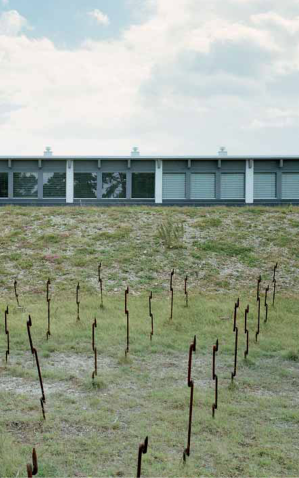New Uses for Old Bunkers #42 : Schadenfreude in the swanky bunker-hotel
January 29, 2017 3 Comments
Here’s a teaser from the final chapter of my forthcoming edited collection, In the Ruins of the Cold War Bunker: Materiality, Affect and Meaning Making…

“Cheap holiday in other people’s misery”
Sex Pistols (1977) Holidays in the Sun
As Per Strömberg notes, abandoned bunkers have become a ‘cultural playground’ (2013, 67), repurposed via the ‘well-established art practice of borrowing or stealing, making new uses for and changing the meaning of objects, images and artefacts of a culture’ (2013, 67), and these interventions are usually spurred by economic agendas of re-use and re-generation (driven by a fear of what might happen if any building is left unused: Bennett 2017), thus (so the logic goes) ‘the cultural alchemy of appropriation turns the materiality of bare concrete walls into new economic value’ (Strömberg 2013, 78).

Strömberg (2013) provides a striking example of a Swedish bunker refurbishment scheme that tries to reconcile economic regeneration, affective authenticity and heritage conservation. The result reveals something very strange about what we appear to what from the bunker. The scheme concerned the Swedish coastal battery fortress of Fårösund on the northern tip of Gotland. The Swedish State’s National Property Board was keen to repurpose this former military site, and to stimulate local employment to redress the job losses of military closures. Accordingly, it supported a proposal for a ‘sympathetic’ heritage-focussed luxury hotel: one where (as Strömberg 2013, 69 notes):
“you can sleep in one of the former bomb shelters furnished as fancy hotel rooms and enjoy a gourmet dinner prepared by fashionable chefs at the place where artillery pieces once were positioned to command the sea. The whole concept is adapted to a military theme. Everything is low-key in colour, scale and finishes: grey and green. Raw materials of local limestone and steel, articulated in a severe minimalism, arouse ‘post-military’ relaxation in the bunker lounge.”
Meanwhile, the perimeter of the site remains ‘authentically’ edged by rusting barbed wire and deserted defence obstacles (presenting as ‘fossils of the military era’ – Strömberg 2013, 70), all now co-opted into the themed hotel’s ‘design scenery’ (69).
This semantic confusion appears to be a vindication of John Beck’s (2011) ‘ambivalence’ thesis: it seems that we may want contradictory things from the bunker, and resolve that incongruity via a wilful conflation of tastes and registers: military – holiday – future – past, all rolled together to service the taste for novel experiences. Our relationship to bunkers, their past, present and future is complex. Perhaps we can detect some evidence of a sublime nostalgia at play – that we can scare ourselves safely now by invoking the atomic- or military-sublime by choosing to visit these places for a short break: safe in the knowledge that this abjection is temporary, of our choosing and that we can choose to leave this experience at any point. Such experience is sublime because we feel that ultimately we are safe – the Cold War has ended, and we have chosen to dabble in this reminiscence or this abjection-lite. This is the ultimate tourism, safely visiting a sanitised version of the past, tasting a remembrance of a childhood fear whilst sipping fine wine.

Jonathan Veitch (2010) takes the point even further – reflecting on his visit to the remains of Survival Town, the mock up cluster of buildings and their mannequin inhabitants, blasted in the civil effects tests held deep in the heart of the Nevada Test Site (NTS) in the 1950s. He admits that there is something erotic in the fascination he feels there: ‘these test houses at the NTS convey, more palpably than any other place I can think of, our longing for apocalypse, the desire to bring everything down around us’ (335).

Meanwhile Marc Lafleur’s (2007) ethnographic study of the 60th anniversary of the Hiroshima / Nagasaki bombings at the National Atomic Museum, Los Alamos, picks out the ‘intimate spectatorship’ and ‘fleeting pit-stops’ (2007, 211) characteristic of touristic/heritage spectacle at Cold War attractions. For him these sites ‘constitute the fleeting and emptied out moments of politics siphoned through shock, sympathy and schadenfreude’ (214). Schadenfreude – because part of the experience is the (sublime-based) knowledge that yours was not the body that was hurt. Shock in the sense of an aestheticized spectacle, the ultimate effect of which is to anaesthetise through overstimulation (in the sense described by Walter Benjamin). Finally, in Sympathy, Lafleur leaves us some glimmer of hope: that such places have the potentiality at least to be ‘gathering points in the new public sphere, places where a ‘we’ can form, however temporarily, in the bloody haze of one more disaster your body has averted’ (215).
References
Beck, John (2011) ‘Concrete Ambivalence: Inside the Bunker Complex’ Cultural Politics 7: 79-102.
Bennett, Luke (2017) ‘Forcing the Empties Back to Work: Ruinphobia and the Bluntness of Law and Policy’ in John Henneberry (ed.) Transience and Dereliction in Urban Development and Property Markets, Chichester: John Wiley & Sons.
Lafleur, Marc (2007) ‘Life and Death in the Shadow of the A-Bomb: Sovereignty and Memory on the 60th anniversary of Hiroshima and Nagasaki’ in Nico Carpentier (ed.) Culture, Trauma, and Conflict: Cultural Studies Perspectives on War. Newcastle: Cambridge Scholars Publishing, pp. 209-228.
Strömberg, Per (2013) ‘Funky Bunkers: The Post-Military Landscape as a Readymade Space and a Cultural Playground’ in Gary A Boyd & Denis Linehan, Ordnance: War + Architecture & Space. Farnham: Ashgate, pp. 67-81.
Veitch, Jonathan (2010) ‘Dr. Strangelove’s Cabinet of Wonder: Sifting through the Atomic Ruins at the Nevada Test Site’ in Julia Hell & Andreas Schönle (eds.) The Ruins of Modernity. London: Duke University Press, pp. 321-338.
Image credits: (1) Barbed wire stands, Fårösund Fortress in Malmros, Sophie (2008). “Fårösunds fästning: från Krimkrig till lyxhotell” (PDF). Kulturvärden (in Swedish) (1): 24–29 : ill (2) Green roof, grey edges, Fårösund Fortress – http://farosundsfastning.com/ (3) Nevada Test Site Dummies – http://falloutshelternyc.blogspot.co.uk/2011/05/nycs-atomic-mannequin-veterans.html; (3) Nagasaki Atomic Bomb Museum -http://twilightzone518.blogspot.co.uk/2014/05/atomic-bomb-museum-nagasaki.html
